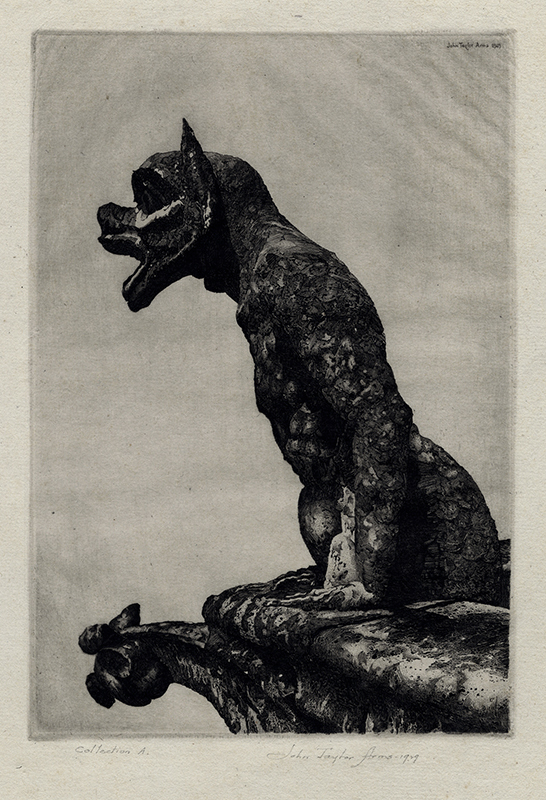Devil of Notre Dame is an etching created in 1929 by the American artist, John Taylor Arms. This impression is pencil signed, dated, and inscribed “Collection A.” It was printed by the artist and Peter Platt on light gray, antique laid ledger paper and is a proof outside of the published edition of 251. The references for this etching are Fletcher 222, Arms 224, LOC 88; and Gargoyle Series no. 13. This early proof measures 8 x 5-1/2 inches platemark.
John Taylor Arms was fascinated by what he termed the Gothic Spirit in early Gothic architecture. One of his focuses was on the elaborate waterspouts on the cathedrals, carved in the shapes of “gargoyles.” In 1920, Arms began a series of forty-one prints featuring various gargoyles and grotesques of the French cathedrals.
This Devil of Notre Dame is a fabulous 19th century addition to the façade of the Gothic Notre Dame Cathedral. It was created under the supervision of the architect Eugène Emmanuel Viollet-le-Duc during a major renovation. This creature is actually a chimèra as it doesn't function as a water spout. It is perched above a horizontal gargoyle on the balustrade of the cathedral's Galerie des Chimères, a balcony that connects the two bell towers. The chimères are grotesque, frightening, and fanciful statues that were thought to ward off evil spirits. John Taylor Arms was a trained architect who felt very deeply that man's greatest achievements in architecture are evidenced in the cathedrals and churches from the Gothic era.
John Taylor Arms, printmaker, lecturer, illustrator, and administrator, was born in Washington, D.C. on 19 April 1887. He first studied law at Princeton University but transferred to the Massachusetts Institute of Technology to study architecture. He studied with Ross Turner, David A. Gregg, and Felton Brown and earned his Master’s Degree in 1912. Following his graduation, Arms worked for the architectural firms Carrere and Hastings, and Clark and Adams before establishing his own architectural firm of which he was a partner.
A gift of an etching kit from his wife, Dorothy, changed the course of his life. He produced his first etching in 1915 and he eventually produced 441 prints, mostly etchings. Arms became one of the most famous printmakers of the first half of the twentieth century. He is mostly noted for his etchings of medieval architecture but early subjects also included ships, sailboats, airplanes, rural landscapes, and the streets, buildings, and bridges of New York.
Arms’ exhibition history was lengthy beginning in 1927 and continuing to 1952. He was given an honorary M.A. degree from Wesleyan University in 1939, and he was a member of the National Academy of Design; the Canadian Painters, Etchers and Engravings; the Royal Society of Painters, Etchers and Engravers; the Society of American Graphic Artists (served as the society's president); the National Institute of Arts and Letters; the American Federation of Arts; the American Artists Professional League; the Architectural League of New York; the Southern States Art League; the Southern Print Makers; the American Color Print Society; the North Shore Art Association; the Washington Water Color Club; the Chicago Society of Etchers; and the Cleveland Print Club.
He authored Hand-Book of Print Making and Print Makers in 1934 and illustrated Churches of France and Hills Town and Cities of Northern Italy by Dorothy Arms.
Arms was an activist for printmaking and assisted in assembling exhibitions of American graphic art that were shown in Sweden, Czechoslovakia and Rome; he was editor of the Print Department of Print, A Quarterly Journal of the Graphic Arts, and he lectured on the techniques, history and value of original prints. Arms also served as the president of the Tiffany Foundation in 1940.
The New York Public Library is the major repository of Arms’ work, but he is also represented in the collections of the Museum of Fine Arts Boston, Massachusetts; the Brooklyn Museum, New York; the Fogg Museum of Art, Harvard University, Cambridge, Massachusetts; the Art Institute of Chicago, Illinois; the Cleveland Museum of Art, Ohio; the Detroit Institute of Arts, Michigan; the Amon Carter Museum of American Art, Fort Worth, Texas; the British Museum and the Victoria and Albert Museum, London; the Los Angeles County Museum, California; the Metropolitan Museum of Art, the National Academy of Design, and the Whitney Museum of American Art, New York; the Fine Arts Museums of San Francisco, California; the Seattle Art Museum, Washington; the Library of Congress and the Smithsonian American Art Museum; Washington, D.C.; and the Worcester Art Museum, Massachusetts.
John Taylor Arms died in New York City on 15 October
1953.



